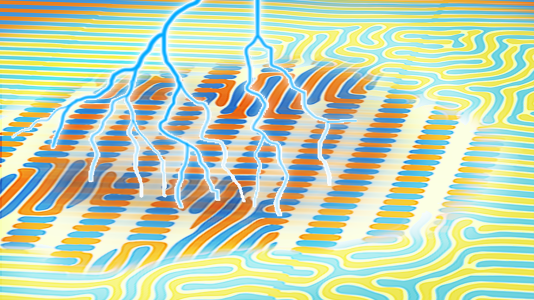A ferroelectric material that can gradually evolve due to photons from light pulses striking the material exhibits unexpected adaptive behavior, according to a study published in Advanced Materials by Argonne researchers.

Artistic rendering representing light pulses yielding adaptive transformations in nanodomain structures applicable to neuromorphic computing. Image Credit: Argonne National Laboratory/Haidan Wen
Scientists have discovered an adaptive response to light pulses that mimics the plasticity of neural networks from a ferroelectric device. This behavior could be useful in microelectronics that use less energy.
Today’s supercomputers and data centers demand many megawatts of power. One challenge is to find materials for more energy-efficient microelectronics. A promising candidate is a ferroelectric material that can be used for artificial neural networks as a component in energy-efficient microelectronics.
Haidan Wen, Physicist, Argonne National Laboratory
Ferroelectric materials are used in various information-processing devices, including actuators, computer memory, sensors, and transistors.
For this study, scientists from DOE’s Lawrence Berkeley National Laboratory, Rice University, and Pennsylvania State University collaborated with Argonne researchers.
This team’s material demonstrates networked islands or domains as distinct as oil in water. These nanometer-sized domains can reorder themselves in response to light pulses, an adaptive behavior that could be applied to microelectronic energy-efficient transmission of information.
The ferroelectric sample used in the study is a sandwich of alternating strontium titanate and lead layers. This seven-layer sandwich, made by the Rice University collaborators, is 1,000 times thinner than a sheet of paper. The group previously produced homogeneous, ordered structures at the nanoscale by applying a single, powerful light pulse to a sample.
“This time, we hit the sample with many weak light pulses, each of which lasts a quadrillionth of a second. As a result, a family of domain structures, rather than a single structure, was created and imaged, depending on the optical dosage.” Wen added.
The team visualized the nanoscale responses using the Nanoprobe (beamline 26-ID), run by the Center for Nanoscale Materials, and the Advanced Photon Source (APS), both of which are Argonne user facilities for the DOE Office of Science. The Nanoprobe exposed the sample to a flurry of ultrafast light pulses while scanning it with an X-ray beam tens of nanometers in diameter.
The resulting images showed that the light pulses created, erased, and reconfigured networked nanodomains. At lengths ranging from 10 nm, roughly 10,000 times smaller than a human hair, to 10 μm, about the size of a cloud droplet, the areas and borders of these domains changed and rearranged. The final product was determined by the number of light pulses used to stimulate the sample.
By coupling an ultrafast laser to the Nanoprobe beamline, we can initiate and control changes to the networked nanodomains by means of light pulses without requiring much energy.
Martin Holt, X-ray and Electron Microscopy Scientist, Argonne National Laboratory
Similar to an adaptive network, the sample starts with a spiderweb-like arrangement of the nanodomains, but the disruption caused by the light pulses causes the web to disintegrate and create completely new configurations that serve a specific goal.
We have discovered entirely new arrangements of these nanodomains. The door is now wide open to many more discoveries. In the future, we will be able to test different regimes of light stimulation and observe even more unknown nanodomains and networks.
Stephan Hruszkewycz, Physicist, Argonne National Laboratory
The recent APS upgrade promises up to 500 times brighter X-ray beams, significantly increasing the ability to visualize nanoscale change over time.
With this groundbreaking discovery of time-dependent changes in networked nanodomains, developers are moving closer to creating adaptive networks for information processing and storage. This development is anticipated to result in more energy-efficient computing systems.
Marc Zajac, Tao Zhou, Tiannan Yang, Sujit Das, Yue Cao, Burak Guzelturk, Vladimir Stoica, Mathew Cherukara, John Freeland, Venkatraman Gopalan, Ramamoorthy Ramesh, Lane Martin, and Long-Qing Chen are among the authors in addition to Wen, Holt, and Hruszkewycz.
DOE Office of Basic Energy Sciences provided funding for the study.
Journal Reference:
Zajac, M. et. al. (2024) Optical Control of Adaptive Nanoscale Domain Networks. Advanced Materials. doi.org/10.1002/adma.202405294